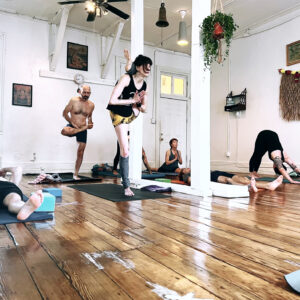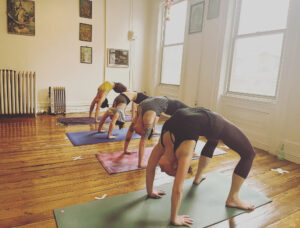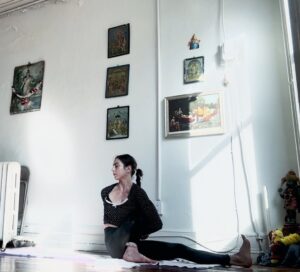Mysore Class
Generally speaking, daily Ashtanga practice happens in a “Mysore Style class.” (Mysore is a city in southern India where the physical practice is rooted.) Although students practice together in the same room, it is not a typical “group class”. Students are encouraged to start their practice at any time within the timeframe of the class so long as they have enough time to finish. Guidance is offered to students on an individual level, taking into account the skill and capabilities of the practitioner so that their practice can flourish. Much of the learning in a Mysore class is based on your relationship with your teacher, they are observing you practice daily, and can provide feedback in hands on and verbal instruction.
a typical “group class”. Students are encouraged to start their practice at any time within the timeframe of the class so long as they have enough time to finish. Guidance is offered to students on an individual level, taking into account the skill and capabilities of the practitioner so that their practice can flourish. Much of the learning in a Mysore class is based on your relationship with your teacher, they are observing you practice daily, and can provide feedback in hands on and verbal instruction.
Led Primary Series
In this class you will be guided through the full primary series. This is a traditionally counted Primary Series class. If you have not learned the  full primary series sequence, you will practice up to the pose you have learned during the Mysore classes. If you are new to Ashtanga and don’t know the sequence the teacher will stop you at an appropriate pose.
full primary series sequence, you will practice up to the pose you have learned during the Mysore classes. If you are new to Ashtanga and don’t know the sequence the teacher will stop you at an appropriate pose.
Practice at home with Elizabeth’s Counted Full Led Primary Download

Pranayama & Subtle Body
Cultivating a deeper understanding of the vayus, nadis, bandhas, kriyas, and breath control.
Friday’s 8:45-9:30am except on moon days
“Pranayama
is the cessation of
the flow of
inhalation and exhalation.”
-Yoga Sutra II:49
Pranayama is the fourth of the 8 limbs of yoga. Pranayama refers to a harnessing and controlling of the breath, working with prana, the life force, or energies that operate the physical, mental, psychological and spiritual aspects of ones being. Prana is the vital energy or life force of all nature. Breathing is the primary function that sustains prana.
These practices deal with the senses, elemental qualities, and the ways we digest and relate to, physical, mental, emotional, spiritual energies. These practices along with the asana practices work in a direct way on nervous system. Breathing is a natural autonomic activity of the nervous system, but through pranayama, one harnesses and controls the breath activity in order effect the subtle energies of the body, and connect more deeply to the life force.
The pranayama practice involves learning to sense, control, and move energy (prana) in powerful and subtle ways. As with ashtanga yoga’s counted vinyasa system that teaches practitioners a minimization of extra, unconscious movements, the pranayamas can create awareness of unconscious fluctuations of the breath and mental chatter, as well as stabilize and reduce these fluctuations.
As a yoga practitioner becomes able to breathe with relative ease, awareness, and receptivity in asana practice, the practice of pranayama may be appropriate, helpful, and enjoyable.
A skilled asana practice both involves pranayama, and prepares us for more advanced, challenging seated pranayama, bandha, and kriya techniques. As one develops a firm enough foundation in the asana practice, and has a comprehensive, clear, sense of ones own energy and relationship to the their world, the pranayama is a beautiful means of entering into and developing the inner world.
One may begin to travel inward towards the more subtle limbs of yoga, Dharana (concentration), Dhyana (meditation), and ultimately Samadhi (absorption). During these classes, Elizabeth teaches some of the ashtanga yoga pranayama sequence, as well as some additional work with bandhas, kriyas, and basic ujjayi breathing.
Introduction to Ashtanga
This class will introduce you to the mysore style class, the traditional, individualized method that characterizes Ashtanga yoga. This is a month long 4 days a week intro to Ashtanga that will provide you with a serious, fun, and safe environment to make a significant beginning in Ashtanga yoga. By learning one posture at a time, you’ll memorize the sequence of postures that make up the introductory or primary series. As you become skilled in performing a posture you’ll be taught the next posture in the sequence. Day by day, posture by posture, through concentration and repetition you will gradually learn the asana’s and transitions that make up Ashtanga’s first series. By attending class in the daily intensive setting, you’ll quickly become comfortable with the mysore style learning format and you’ll see how effective the method can be in helping you create a personal practice. This course will prepare you to participate in the ongoing mysore program at AYP. Class is limited to five students.